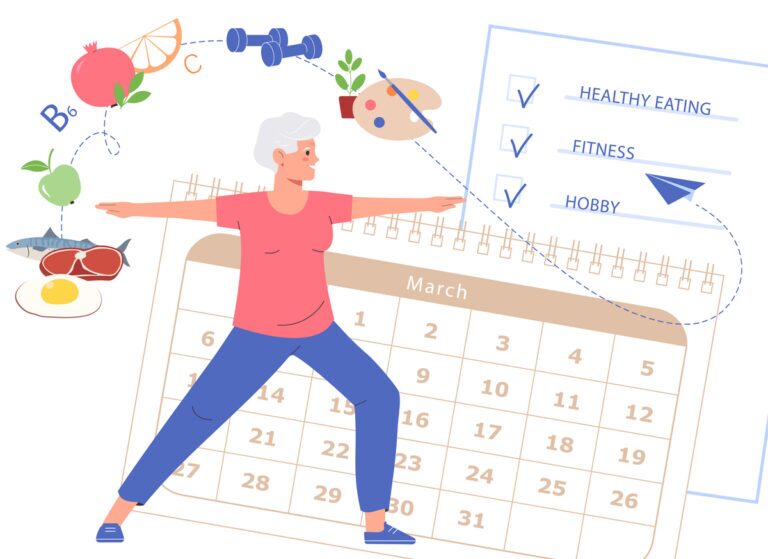Retirement is often seen as a well-earned break from the hectic pace of working life. But for many, the sudden loss of daily structure can feel disorienting and even a little isolating. Some seniors fall into a pattern that includes too much television and not enough activity and social engagement, and it can be a very difficult pattern to break.
That’s why having a well-crafted wellness routine is so important. It can help you maintain your physical health, mental clarity and emotional well-being so you can make the most of this new chapter. Here are a few tips to help you get started on your own personal plan.
1. Define Your Wellness Goals
The first step in building a successful wellness routine is identifying what “wellness” means to you. Are you hoping to reduce the stress that’s been a part of your work life for decades? Or improve your level of physical fitness? Whatever your goal, be sure to document it in your plan—it will give your routine direction and purpose. Be specific and realistic. For example, you might set a goal to take a yoga class at least twice a week or walk every weekday morning for 20 minutes.
2. Design a Balanced Daily Schedule
While retirement offers freedom, having some structure in your day is essential. A balanced routine includes time for physical activity, mental engagement, rest, social interaction and self-care. This example might give you some ideas for developing a healthy daily retirement routine of your own:
- Morning: Light exercise (like walking or stretching), followed by a healthy breakfast and reading or journaling
- Afternoon: Lunch with a friend or family member, and then engaging in a favorite hobby or attending a class (painting, gardening, learning online)
- Evening: Social time (calls with family, dinner with friends) or relaxing activities like watching a film or listening to music
Consistency will help your body and mind stay in rhythm, while flexibility will ensure you can enjoy spontaneity without losing your wellness focus.
3. Stay Physically Active
Physical activity is one of the most important components of a wellness routine. Regular movement supports heart health, mobility, balance and mental clarity. Aim for at least 30 minutes of moderate activity on most days, whether it’s walking, swimming, cycling or taking a fitness class designed for seniors. Incorporate strength training twice a week to help maintain muscle mass and bone density.
4. Prioritize Mental and Emotional Wellness
Retirement can sometimes bring on feelings of loneliness or loss of identity. Keep your mind active by reading, solving puzzles, learning something new or volunteering. Stay emotionally connected through regular social interactions—whether it’s lunch with friends, community events or family visits. Practicing mindfulness, meditation or gratitude journaling can also support emotional balance and reduce anxiety.
5. Eat for Body and Brain Health
Your nutrition habits significantly influence your energy and mood, as well as your physical and brain health. Focus on whole foods, such as fruits, vegetables, lean proteins, whole grains and healthy fats. It’s also important to stay hydrated, limit processed foods and avoid excessive alcohol consumption. If you aren’t sure what a healthy diet for a retiree looks like, ask your doctor for a referral to a nutritionist. They can help you create meals and menus that will allow you to live retirement to the fullest.
6. Listen to Your Body
One of the advantages of retirement is having more time to listen to your body’s cues. Rest when you’re tired, eat when you’re hungry and move when you feel restless. Also be mindful of how much stress you are experiencing. Chronic stress can lead to a variety of medical issues, ranging from depression to high blood pressure. Don’t be afraid to adjust your routine based on how you feel. Wellness is not a fixed destination—it evolves with your needs.
7. Celebrate Small Wins
Finally, acknowledge your progress. Whether you hit or exceeded your steps goal for the week, joined an art class or simply felt more positive, celebrating small victories will keep you motivated and reinforce the value of your wellness routine.
Get Started TODAY!
If your retirement dream includes moving to an active lifestyle community, we have a resource you’ll find useful. The ASC Independent Living Decision Toolkit is packed with the information and answers seniors need to choose the right community to call home. Download it today with our compliments!
Even if you’re not ready to join a senior living community, you can still take advantage of New Energy Wellness. This program is open to the public and offers a fitness experience designed specifically to help seniors build and maintain a healthy routine. Find a New Energy Wellness location near you!




